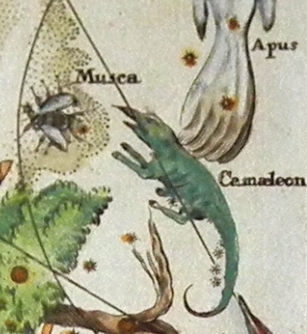Chamaeleon on:
[Wikipedia]
[Google]
[Amazon]
Chamaeleon () is a small
 Chamaeleon was one of twelve constellations created by Petrus Plancius from the observations of
Chamaeleon was one of twelve constellations created by Petrus Plancius from the observations of
 In 1999, a nearby
In 1999, a nearby
The Deep Photographic Guide to the Constellations: Chamaeleon
"The eta Chamaeleontis Cluster: A Remarkable New Nearby Young Open Cluster" (Mamajek, Lawson, & Feigelson 1999)
"WEBDA open cluster database entry for Mamajek 1"
NGC 3620 Barred spiral galaxy
{{DEFAULTSORT:Chamaeleon Southern constellations Constellations listed by Petrus Plancius
constellation
A constellation is an area on the celestial sphere in which a group of visible stars forms Asterism (astronomy), a perceived pattern or outline, typically representing an animal, mythological subject, or inanimate object.
The first constellati ...
in the deep southern sky. It is named after the chameleon, a kind of lizard
Lizard is the common name used for all Squamata, squamate reptiles other than snakes (and to a lesser extent amphisbaenians), encompassing over 7,000 species, ranging across all continents except Antarctica, as well as most Island#Oceanic isla ...
. It was first defined in the 16th century.
History
 Chamaeleon was one of twelve constellations created by Petrus Plancius from the observations of
Chamaeleon was one of twelve constellations created by Petrus Plancius from the observations of Pieter Dirkszoon Keyser
Pieter Dirkszoon Keyser (occasionally Petrus Theodorus; – 11 September 1596) was a Dutch navigator and celestial cartographer who mapped several constellations on the southern celestial hemisphere.
Voyages and star observation
Little is ...
and Frederick de Houtman. It first appeared on a 35-cm diameter celestial globe published in 1597 (or 1598) in Amsterdam
Amsterdam ( , ; ; ) is the capital of the Netherlands, capital and Municipalities of the Netherlands, largest city of the Kingdom of the Netherlands. It has a population of 933,680 in June 2024 within the city proper, 1,457,018 in the City Re ...
by Plancius and Jodocus Hondius. Johann Bayer was the first uranographer to put Chamaeleon in a celestial atlas. It was one of many constellations created by European explorers in the 15th and 16th centuries out of unfamiliar Southern Hemisphere stars.
Features
Stars
There are four bright stars in Chamaeleon that form a compact diamond-shape approximately 10 degrees from the south celestial pole and about 15 degrees south of Acrux, along the axis formed by Acrux and Gamma Crucis. Alpha Chamaeleontis is a white-hued star of magnitude 4.1, 63 light-years from Earth. Beta Chamaeleontis is a blue-white hued star of magnitude 4.2, 271 light-years from Earth. Gamma Chamaeleontis is a red-hued giant star of magnitude 4.1, 413 light-years from Earth. The other bright star in Chamaeleon is Delta Chamaeleontis, a wide double star. The brighter star is Delta2 Chamaeleontis, a blue-hued star of magnitude 4.4. Delta1 Chamaeleontis, the dimmer component, is an orange-hued giant star of magnitude 5.5. They both lie about 350 light years away. Chamaeleon is also the location of Cha 110913, a unique dwarf star or proto solar system.Deep-sky objects
 In 1999, a nearby
In 1999, a nearby open cluster
An open cluster is a type of star cluster made of tens to a few thousand stars that were formed from the same giant molecular cloud and have roughly the same age. More than 1,100 open clusters have been discovered within the Milky Way galaxy, and ...
was discovered centered on the star η Chamaeleontis. The cluster, known as either
the Eta Chamaeleontis cluster or Mamajek 1, is 8 million years old, and lies 316 light years from Earth.
The constellation contains a number of molecular clouds (the Chamaeleon dark clouds) that are forming low-mass T Tauri star
T Tauri stars (TTS) are a class of variable stars that are less than about ten million years old. This class is named after the prototype, T Tauri, a young star in the Taurus Molecular Cloud, Taurus star-forming region. They are found near mo ...
s. The cloud complex lies some 400 to 600 light years from Earth, and contains tens of thousands of solar masses of gas and dust. The most prominent cluster of T Tauri stars and young B-type stars are in the Chamaeleon I cloud, and are associated with the reflection nebula IC 2631.
Chamaeleon contains one planetary nebula, NGC 3195, which is fairly faint. It appears in a telescope at about the same apparent size as Jupiter
Jupiter is the fifth planet from the Sun and the List of Solar System objects by size, largest in the Solar System. It is a gas giant with a Jupiter mass, mass more than 2.5 times that of all the other planets in the Solar System combined a ...
.
Equivalents
InChinese astronomy
Astronomy in China has a long history stretching from the Shang dynasty, being refined over a period of more than 3,000 years. The Ancient China, ancient Chinese people have identified stars from 1300 BCE, as Chinese star names later categori ...
, the stars that form Chamaeleon were classified as the Little Dipper () among the Southern Asterisms () by Xu Guangqi. Chamaeleon is sometimes also called the Frying Pan in Australia.
See also
* Chamaeleon (Chinese astronomy) * IAU-recognized constellationsCitations
References
* * *External links
The Deep Photographic Guide to the Constellations: Chamaeleon
"The eta Chamaeleontis Cluster: A Remarkable New Nearby Young Open Cluster" (Mamajek, Lawson, & Feigelson 1999)
"WEBDA open cluster database entry for Mamajek 1"
NGC 3620 Barred spiral galaxy
{{DEFAULTSORT:Chamaeleon Southern constellations Constellations listed by Petrus Plancius